
• An extension cord must have adequate wire size (AWG or American Wire Gauge) for
safety. The smaller the gauge number of the wire, the greater the capacity of the cable, that is,
16 gauge has more capacity than 18 gauge. An undersized cord will cause a drop in line voltage
resulting in loss of power and overheating. When using more than one extension to make up
the total length, be sure each individual extension contains at least the minimum wire size. The
following table shows the correct size to use depending on cord length and nameplate ampere
rating. If in doubt, use the next heavier gauge. The lower the gauge number, the heavier the
cord.
Minimum Gauge for Cord Sets
Ampere Rating
Volts Total Length of Cord in Feet (meters)
120V 25 (7.6) 50 (15.2) 100 (30.5) 150 (45.7)
240V 50 (15.2) 100 (30.5) 200 (61.0) 300 (91.4)
More
Than
Not More
Than
AWG
0 6 18 16 16 14
610 18161412
10 12 16 16 14 12
12 16 14 12 Not Recommended
• Do not place any object on top of the charger or place the charger on a soft surface
that might block the ventilation slots and result in excessive internal heat. Place the
charger in a position away from any heat source. The charger is ventilated through slots in the
top and the bottom of the housing.
• Do not operate the charger with a damaged cord or plug.
• Do not operate the charger if it has received a sharp blow, been dropped or otherwise
damaged in any way. Take it to an authorized service center.
• Do not disassemble the charger; take it to an authorized service center when service
or repair is required. Incorrect reassembly may result in a risk of electric shock, electrocution or
fire.
• Disconnect the charger from the outlet before attempting any cleaning. This will
reduce the risk of electric shock. Removing the battery pack will not reduce this risk.
• NEVER attempt to connect two chargers together.
• The charger is designed to operate on standard 120 volt household electrical power.
Do not attempt to use it on any other voltage. This does not apply to the vehicular charger.
Chargers
Your tool uses a DEWALT charger. Be sure to read all safety instructions before using your charger.
Consult the chart at the end of this manual for compatibility of chargers and battery packs.
Charging Procedure (Fig. 4)
1. Plug the charger into an appropriate outlet before inserting the battery pack.
2. Insert the battery pack (F) into the charger, as shown in Figure 4, making sure the pack is fully
seated in charger. The red (charging) light will blink continuously, indicating that the charging
process has started.
3. The completion of charge will be indicated by the red light remaining ON continuously. The pack
is fully charged and may be used at this time or left in the charger.
Indicator Light Operation
PACK CHARGING
PACK CHARGED
x
HOT/COLD DELAY
PROBLEM PACK OR CHARGER
PROBLEM POWERLINE
Charge Indicators
This charger is designed to detect certain problems that can arise. Problems are indicated by the red
light flashing at a fast rate. If this occurs, re-insert the battery pack into the charger. If the problem
persists, try a different battery pack to determine if the charger is working properly. If the new pack
charges correctly, then the original pack is defective and should be returned to a service center or
other collection site for recycling. If the new battery pack elicits the same trouble indication as the
original, have the charger and the battery pack tested at an authorized service center.
HOT/COLD DELAY
This charger has a hot/cold delay feature: when the charger detects a battery that is hot, it
automatically starts a delay, suspending charging until the battery has cooled. After the battery
has cooled, the charger automatically switches to the pack charging mode. This feature ensures
maximum battery life. The red light flashes long, then short while in the hot/cold delay mode.
LEAVING THE BATTERY PACK IN THE CHARGER
The charger and battery pack can be left connected with the charge indicator showing Pack
Charged.
WEAK BATTERY PACKS: Weak batteries will continue to function but should not be expected
to perform as much work.
FAULTY BATTERY PACKS: This charger will not charge a faulty battery pack. The charger will
indicate faulty battery pack by refusing to light or by displaying problem pack or charger.
NOTE: This could also mean a problem with a charger.
PROBLEM POWER LINE
Some chargers have a Problem Powerline indicator. When the charger is used with some portable
power sources such as generators or sources that convert DC to AC, the charger may temporarily
suspend operation, flashing the red light with two fast blinks followed by a pause. This
indicates the power source is out of limits.
Important Charging Notes
1. Longest life and best performance can be obtained if the battery pack is charged when the air
temperature is between 65°F and 75°F (18° – 24°C). DO NOT charge the battery pack in an
air temperature below +40°F (+4.5°C), or above +105°F (+40.5°C). This is important and will
prevent serious damage to the battery pack.
2. The charger and battery pack may become warm to the touch while charging. This is a normal
condition, and does not indicate a problem. To facilitate the cooling of the battery pack after
use, avoid placing the charger or battery pack in a warm environment such as in a metal shed
or an uninsulated trailer.
3. A cold battery pack will charge at about half the rate of a warm battery pack. The battery
pack will charge at that slower rate throughout the entire charging cycle and will not return to
maximum charge rate even if the battery pack warms.
4. If the battery pack does not charge properly:
a. Check operation of receptacle by plugging in a lamp or other appliance;
b. Check to see if receptacle is connected to a light switch which turns power off when you
turn out the lights;
c. Move the charger and battery pack to a location where the surrounding air temperature is
approximately 65°F – 75°F (18° – 24°C);
d. If charging problems persist, take the tool, battery pack and charger to your local service
center.
5. The battery pack should be recharged when it fails to produce sufficient power on jobs which
were easily done previously. DO NOT CONTINUE to use under these conditions. Follow the
charging procedure. You may also charge a partially used pack whenever you desire with no
adverse effect on the battery pack.
6. Foreign materials of a conductive nature such as, but not limited to, grinding dust, metal chips,
steel wool, aluminum foil, or any buildup of metallic particles should be kept away from charger
cavities. Always unplug the charger from the power supply when there is no battery pack in the
cavity. Unplug the charger before attempting to clean.
7. Do not freeze or immerse the charger in water or any other liquid.
WARNING: Shock hazard. Don’t allow any liquid to get inside the charger. Electric shock may
result.
WARNING: Burn hazard. Do not submerge the battery pack in any liquid or allow any liquid
to enter the battery pack. Never attempt to open the battery pack for any reason. If the plastic
housing of the battery pack breaks or cracks, return to a service center for recycling.
Storage Recommendations
1. The best storage place is one that is cool and dry, away from direct sunlight and excess heat
or cold.
2. For long storage, it is recommended to store a fully charged battery pack in a cool dry place
out of the charger for optimal results.
NOTE: Battery packs should not be stored completely depleted of charge. The battery pack will
need to be recharged before use.
SAVE THESE INSTRUCTIONS FOR FUTURE USE
COMPONENTS (Fig. 1, 2)
WARNING: Never modify the power tool or any part of it. Damage or personal injury could
result.
A. Trigger switch F. Battery pack
B. Forward/reverse button G. Worklight
C. Anvil H. Detent pin (DCF889)
D. Main handle I. Hog ring (DCF889H)
E. Battery release button
INTENDED USE
This impact wrench is designed for professional impact fastening applications. The impact function
makes this tool particularly useful for driving fasteners in wood, metal and concrete. DO NOT use
under wet conditions or in presence of flammable liquids or gases.
This impact wrench is a professional power tool. DO NOT let children come into contact with the
tool. Supervision is required when inexperienced operators use this tool.
OPERATION
WARNING: To reduce the risk of serious personal injury, place the forward/reverse
button in the lock-off position or turn tool off and disconnect battery pack before making
any adjustments or removing/installing attachments or accessories. An accidental start-up
can cause injury.
Installing and Removing the Battery Pack (Fig. 5)
NOTE: For best results, make sure your battery pack is fully charged.
To install the battery pack (F) into the tool handle, align the battery pack with the rails inside the
tool’s handle and slide it into the handle until the battery pack is firmly seated in the tool and ensure
that it does not disengage.
To remove the battery pack from the tool, press the release button (E) and firmly pull the battery
pack out of the tool handle. Insert it into the charger as described in the charger section of this
manual.
FUEL GAUGE BATTERY PACKS (FIG.6)
Some D
EWALT battery packs include a fuel gauge which consists of three green LED lights that
indicate the level of charge remaining in the battery pack.
To actuate the fuel gauge, press and hold the fuel gauge button (J). A combination of the three
green LED lights will illuminate designating the level of charge left. When the level of charge in the
battery is below the usable limit, the fuel gauge will not illuminate and the battery will need to be
recharged.
NOTE: The fuel gauge is only an indication of the charge left on the battery pack. It does not
indicate tool functionality and is subject to variation based on product components, temperature
and end-user application.
For more information regarding fuel gauge battery packs, please call 1-800-4-DEWALT (1-800-433-
9258) or visit our website www.dewalt.com.
Proper Hand Position (Fig. 1, 7)
WARNING: To reduce the risk of serious personal injury, ALWAYS use proper hand position as shown.
WARNING: To reduce the risk of serious personal injury, ALWAYS hold securely in anticipation of a sudden
reaction.
Proper hand position requires one hand on the main handle (D).
Variable Speed Trigger Switch (Fig. 1)
To turn the tool on, squeeze the trigger switch (A). To turn the tool off, release the trigger switch.
Your tool is equipped with a brake. The anvil will stop when the trigger switch is fully released. The
variable speed switch enables you to select the best speed for a particular application. The more
you squeeze the trigger, the faster the tool will operate. For maximum tool life, use variable speed
only for starting holes or fasteners.
NOTE: Continuous use in variable speed range is not recommended. It may damage the switch
and should be avoided.
Forward/Reverse Control Button (Fig. 1)
A forward/reverse control button (B) determines the direction of the tool and also serves as a lock-off
button.
To select forward rotation, release the trigger switch and depress the forward/reverse control button
on the right side of the tool.
To select reverse, release the trigger switch and depress the forward/reverse control button on the
left side of the tool.
The center position of the control button locks the tool in the OFF position. When changing the
position of the control button, be sure the trigger is released.
NOTE: The first time the tool is run after changing the direction of rotation, you may hear a click
on start up. This is normal and does not indicate a problem.
Worklight (Fig. 1)
There is a worklight (G) located on the foot of the tool. The worklight is activated when the trigger
switch is depressed, and will automatically turn off 20 seconds after the trigger switch is released.
If the trigger switch remains depressed, the worklight will remain on.
NOTE: The worklight is for lighting the immediate work surface and is not intended to be used as
a flashlight.
Anvils (Fig. 2, 3)
WARNING: Use only impact accessories. Non-impact accessories may break and cause a
hazardous condition. Inspect accessories prior to use to ensure that it con tains no cracks.
CAUTION: Inspect anvils, detent pins and hog rings prior to use. Missing or damaged items
should be replaced before use.
Place the switch in the locked off (center) position or remove battery pack before changing
accessories.
ANVIL WITH DETENT PIN (FIG. 2)
DCF889
To install an accessory on the anvil, align the hole in the side of the accessory with the detent
pin (H) on the anvil (C). Press the accessory on until the detent pin engages in the hole. Depression
of detent pin may be necessary to aid installation of accessory.
To remove an accessory, depress the detent pin through the hole and pull the accessory off.
ANVIL WITH HOG RING (FIG. 3)
DCF889H
To install an accessory on the hog ring anvil, firmly push accessory onto the anvil (C). The
hog ring (I) compresses to allow the accessory to slide on. After accessory is installed, the hog ring
applies pressure to help provide accessory retention.
To remove an accessory, grasp the accessory and firmly pull it off.
Usage
Your impact tool can generate the following maximum torque:
Cat # Ft.-Lbs. In.-Lbs. Nm
DCF889 400 4800 540
DCF889H 400 4800 540
CAUTION: Ensure fastener and/or system will withstand the level of torque generated by the
tool. Excessive torque may cause breakage and possible personal injury.
1. Place the accessory on the fastener head. Keep the tool pointed straight at the fastener.
2. Press switch to start operation. Release switch to stop operation. Always check torque with a
torque wrench, as the fastening torque is affected by many factors including the following:
• Voltage: Low voltage, due to a nearly discharged battery, will reduce fastening torque.
• Accessory size: Failure to use the correct accessory size will cause a reduction in
fastening torque.
• Bolt size: Larger bolt diameters generally require higher fastening torque. Fastening torque
will also vary according to length, grade, and torque coefficient.
• Bolt: Ensure that all threads are free of rust and other debris to allow proper fastening
torque.
• Material: The type of material and surface finish of the material will affect fastening torque.
• Fastening time: Longer fasten ing time results in increased fastening torque. Using a
longer fastening time than recom mended could cause the fasteners to be overstressed,
stripped or damaged.
MAINTENANCE
WARNING: To reduce the risk of serious personal injury, place the forward/reverse
button in the lock-off position or turn tool off and disconnect battery pack before making
any adjustments or removing/installing attachments or accessories. An accidental start-up
can cause injury.
Cleaning
WARNING: Blow dirt and dust out of all air vents with clean, dry air at least once a week.
To minimize the risk of eye injury, always wear ANSI Z87.1 approved eye protection when
performing this.
WARNING: Never use solvents or other harsh chemicals for cleaning the non-metallic parts of
the tool. These chemicals may weaken the plastic materials used in these parts. Use a cloth
dampened only with water and mild soap. Never let any liquid get inside the tool; never immerse
any part of the tool into a liquid.
CHARGER CLEANING INSTRUCTIONS
WARNING: Shock hazard. Disconnect the charger from the AC outlet before cleaning. Dirt and
grease may be removed from the exterior of the charger using a cloth or soft non-metallic brush.
Do not use water or any cleaning solutions.
FIG. 5
E
F
FIG. 3
I
C
J
FIG. 6
FIG. 2
H
C
DCF889
DCF889H
DCF889
FIG. 7
FIG. 4
F
C
G
A
D
F
B
FIG. 1
E

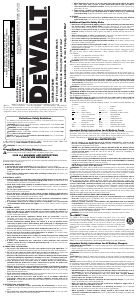


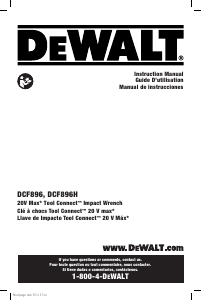
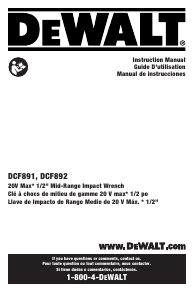
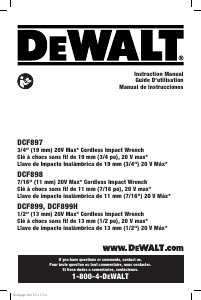
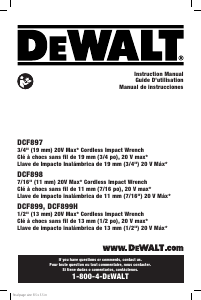
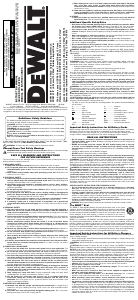
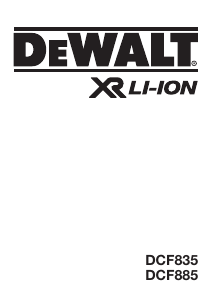
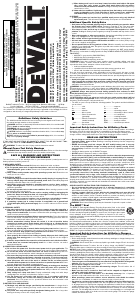
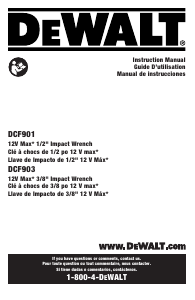
Join the conversation about this product
Here you can share what you think about the DeWalt DCF889HM2 Impact Wrench. If you have a question, first carefully read the manual. Requesting a manual can be done by using our contact form.